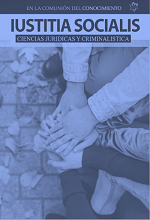Prison system and increased violence during the pandemic
DOI:
https://doi.org/10.35381/racji.v5i3.1122Keywords:
Pandemic, violence, justice.Abstract
It is important to know that prisons, inmates and prison staff are an especially vulnerable area in the face of the spread of the COVID-19 pandemic. The research is shown from a quantitative perspective, the objective is to alert about the danger that prisons have during the spread of the coronavirus and its relationship with the prison system. It is of the documentary-bibliographic type. The information was collected in a single moment, in a single time, collecting data directly from the scrutinized narratives related to reality. Subsequently, brief contributions were developed that contribute to raise a great debate on the violation of the human rights of those deprived of liberty in the midst of this pandemic. It is concluded that the prisoners is a penitentiary system, which cannot provide cleanliness, nor provide basic services, the lack of sanitation is a source to continue increasing the virus and increasing violence.
Downloads
References
Aguirre-Salas, A (2020. Sistema penitenciario y población penalizada durante la Revolución Ciudadana (2007-2017). [Penitentiary System and Penalized Population During the Revolución Ciudadana” Decade (2007-2017)]. URVIO, Revista Latinoamericana de Estudios de Seguridad, 27,94-110. doi.org/10.17141/urvio.27.2020.4303
Asamblea Nacional Constituyente de la República del Ecuador, (2008). Constitución de la República del Ecuador. Montecristi. Registro Oficial 449 de 20-oct-2008. Recuperado de https://n9.cl/sia
Asamblea Nacional de la República del Ecuador. (2014). Código Orgánico Integral Penal [Comprehensive Organic Criminal Code]. Recuperado de https://n9.cl/g6sc
Bavaresco, A. (2013) Proceso metodológico en la investigación. [Methodological process in research]. Imprenta internacional. 6ta edición. Maracaibo. Venezuela
González, M. (9 de diciembre de 2019) En 2020 las cárceles tendrán menos dinero y los mismos problemas. [By 2020, prisons will have less money and the same problems] Recuperado de: https://n9.cl/1fdy
Guimarães, Alice Soares, MacLean Soruco, Enrique, & Eguivar, Mario A. (2020). Cárcel, derechos humanos y salud pública en el contexto de la pandemia COVID-19. [Prison, human rights and public health in the context of the COVID-19 pandemic]. Revista Latinoamericana de Desarrollo Económico, (34), 35-66. Recuperado de: https://n9.cl/n9fp
Hernández, R. y otros. (2008) Metodología de la investigación. [Research methodology]. 4ta edición. Editorial McGrawHill. Interamericana. México.
La presencia del COVID-19 en cárceles de Ecuador causa alarma; hay 502 casos confirmados (2020). [The presence of COVID-19 in prisons in Ecuador causes alarm; there are 502 confirmed cases (2020)]. El Universo. Recuperado de: https://n9.cl/arip
Plataforma Periodística para las Américas (2020). Sentencia de olvido. [Sentence of forgetfulness]. CONNECTAS. Recuperado de: https://n9.cl/qu9vx
Piscetta, J. (6 de octubre de 2020). Durante la cuarentena, la cantidad de detenidos en las comisarías bonaerenses aumentó más que en todo 2019. [During quarantine, the number of detainees at Bonaerenses police stations increased more than in all of 2019]. Recuperado de: https://n9.cl/z5roh
Pontón, D. (2020). Las cárceles y el coronavirus en Ecuador: ¿un coctel explosivo? [ Prisons and coronavirus in Ecuador: an explosive cocktail? Recuperado de https://n9.cl/5bft
Published
How to Cite
Issue
Section
License
CC BY-NC-SA : Esta licencia permite a los reutilizadores distribuir, remezclar, adaptar y construir sobre el material en cualquier medio o formato solo con fines no comerciales, y solo siempre y cuando se dé la atribución al creador. Si remezcla, adapta o construye sobre el material, debe licenciar el material modificado bajo términos idénticos.
OAI-PMH URL: https://fundacionkoinonia.com.ve/ojs/index.php/Iustitia_Socialis/oai










